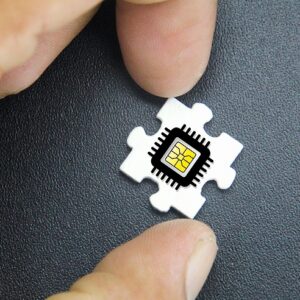From automakers to home appliance stores, business owners are reeling from microchip shortages spurred by the COVID-19 pandemic. Over the last 20 months, I’ve spent countless nights scouring the internet to source microchips and other parts that my business needs to maintain production.
Our entire semiconductor industry — and most of our electronics — hinges on a handful of geographically concentrated manufacturers, with more than 60 percent in Taiwan. There isn’t sufficient domestic manufacturing capacity, and businesses have few options to solve the shortage other than hoping, waiting and scrambling to survive.
I started my company in 1999. Today, our focus is on inertial motion-sensing devices, and we hold a dozen patents, employ 12 people, and perform all our engineering and manufacturing in America. But nothing would prepare us for the nightmare scenario that is the global microchip shortage.
Without access to components, we can neither innovate new products nor build existing products to sell. When we find parts inventory, it may come from somewhat risky gray-market suppliers. We wouldn’t know if the components from those suppliers were defective, counterfeit or otherwise questionable. Since chip malfunctions can cause system failures, economic loss or injury to consumers, the risks are significant.
In a business where we make things to sell, we can’t sell anything if we can’t get components. Even inexpensive, passive components like resistors or capacitors have been in short supply, meaning that parts worth less than a penny can stop production on the entire system.
When the shortages began, people started buying and hoarding, causing parts worth $4 or less to balloon to $80 to $90 per unit. Previously pre-negotiated prices with reliable suppliers had to be replaced with higher-cost parts from questionable suppliers. We were forced to either eat the costs or pass those costs on to customers. This means those using our technology in their products must now make those same difficult pricing decisions. It’s no wonder these shortages drove inflation throughout the entire market.
When we can’t find parts for our products, we must redesign entire systems to switch from one chip to another. Charting a path forward where components are increasingly scarce is a battle. After a redesign, alternative parts that were once available also disappeared, and we are scrambling to make a backup plan for our backup plan. I want to create products and get back to innovating, but without security in our supply chain, research-and-development is essentially stalled.
It seemed like the component shortage was to remain an unaddressed nightmare, until the Biden administration passed the CHIPS and Science Act in August, investing more than $50 billion in semiconductor research and development, manufacturing, and workforce development. The law’s announcement then spurred an additional $200 billion in private investment for domestic production. Since then, 40-plus new domestic projects that will generate 40,000 jobs have been announced.
Although it will be several years before the microchips produced in these new factories will hit the market, the CHIPS Act will create thousands of jobs in the planning and constructing of new projects.
As a professor, I’m thrilled to see expanded funding for STEM education to develop a workforce employed in the new factories. I hope my students will see more job opportunities and keep their entrepreneurial and innovative ideas within the United States.
Under this administration’s leadership, America took a critical step toward ensuring that no one company or one country controls the only thing that keeps our high-tech world running.


